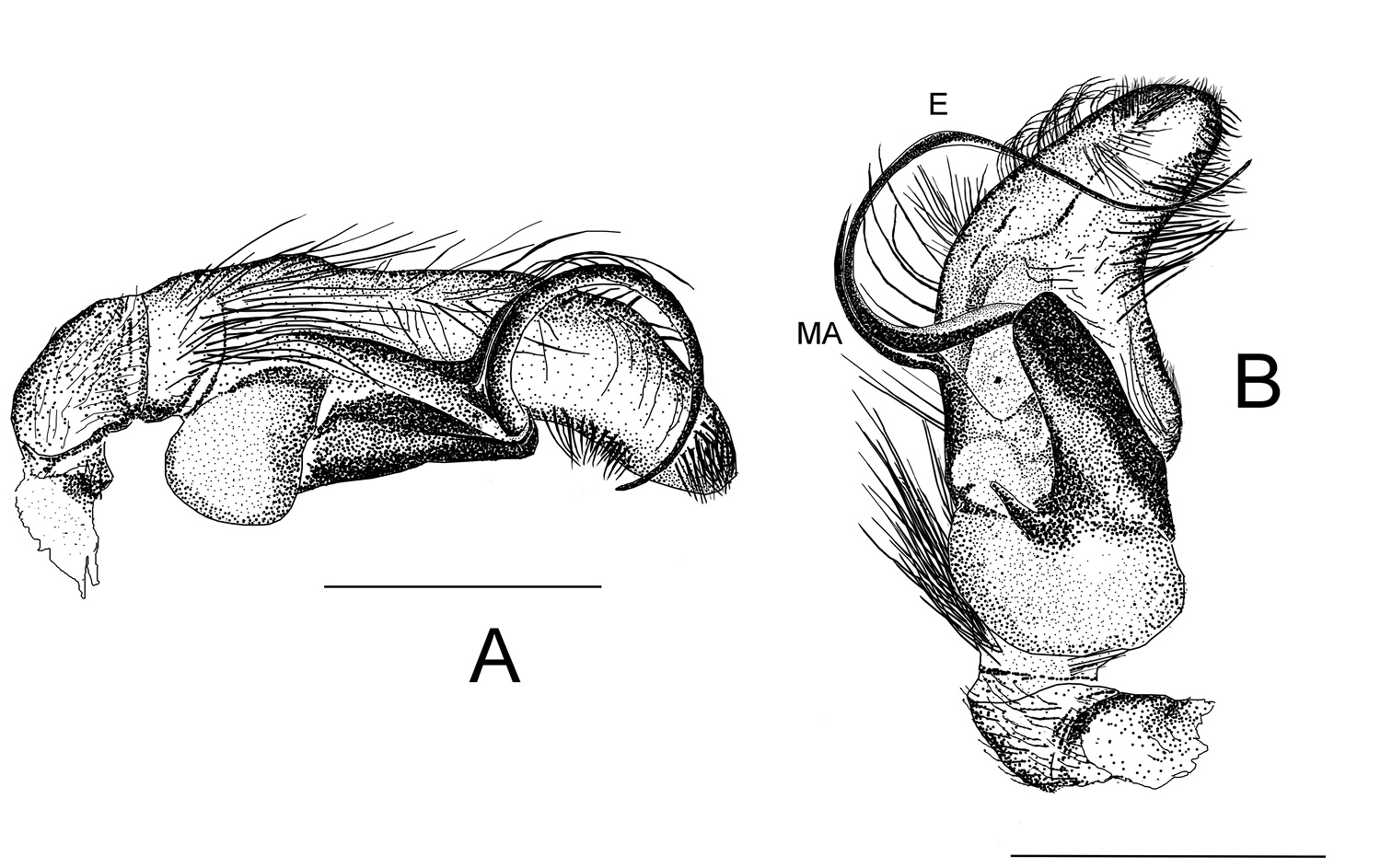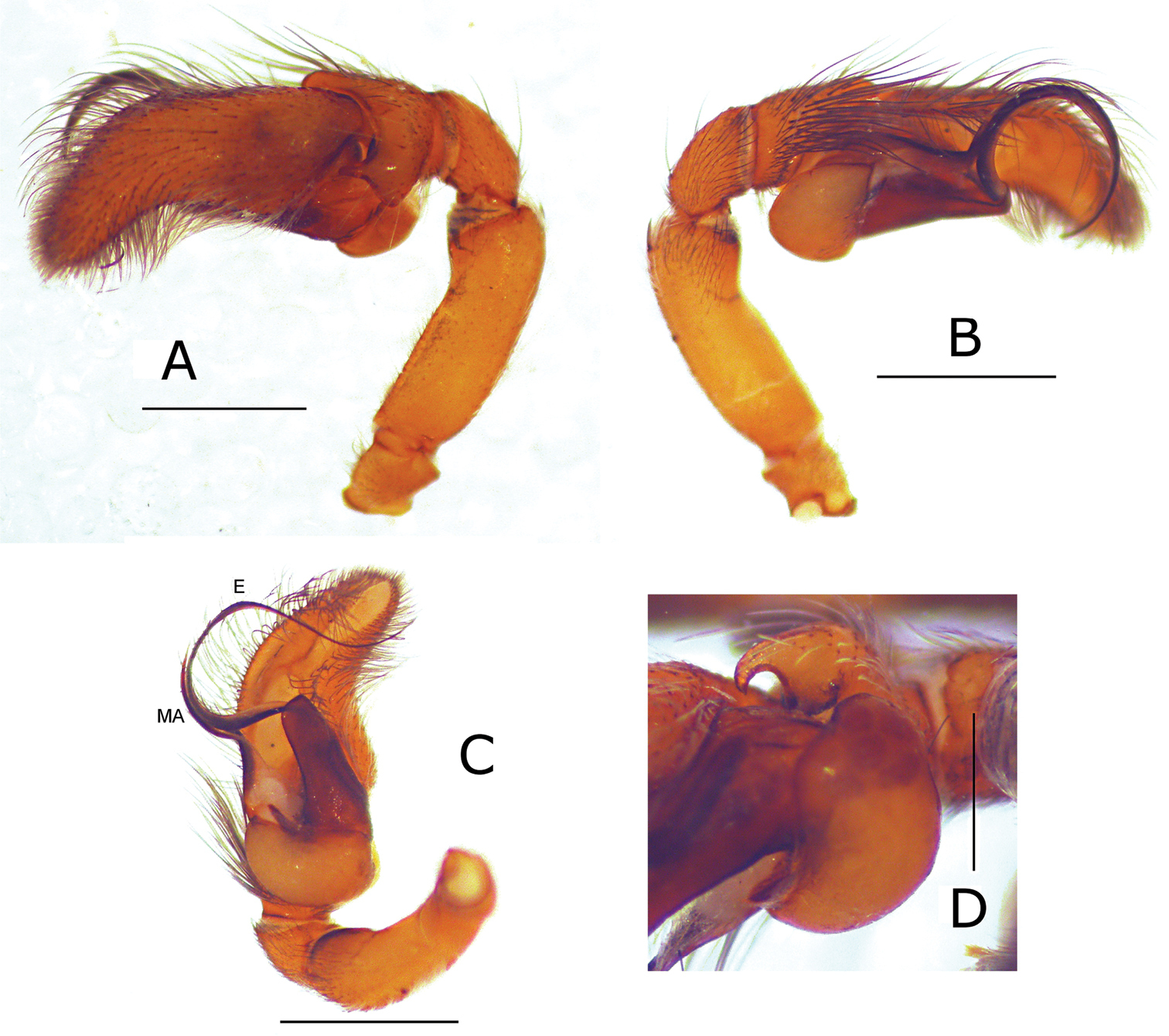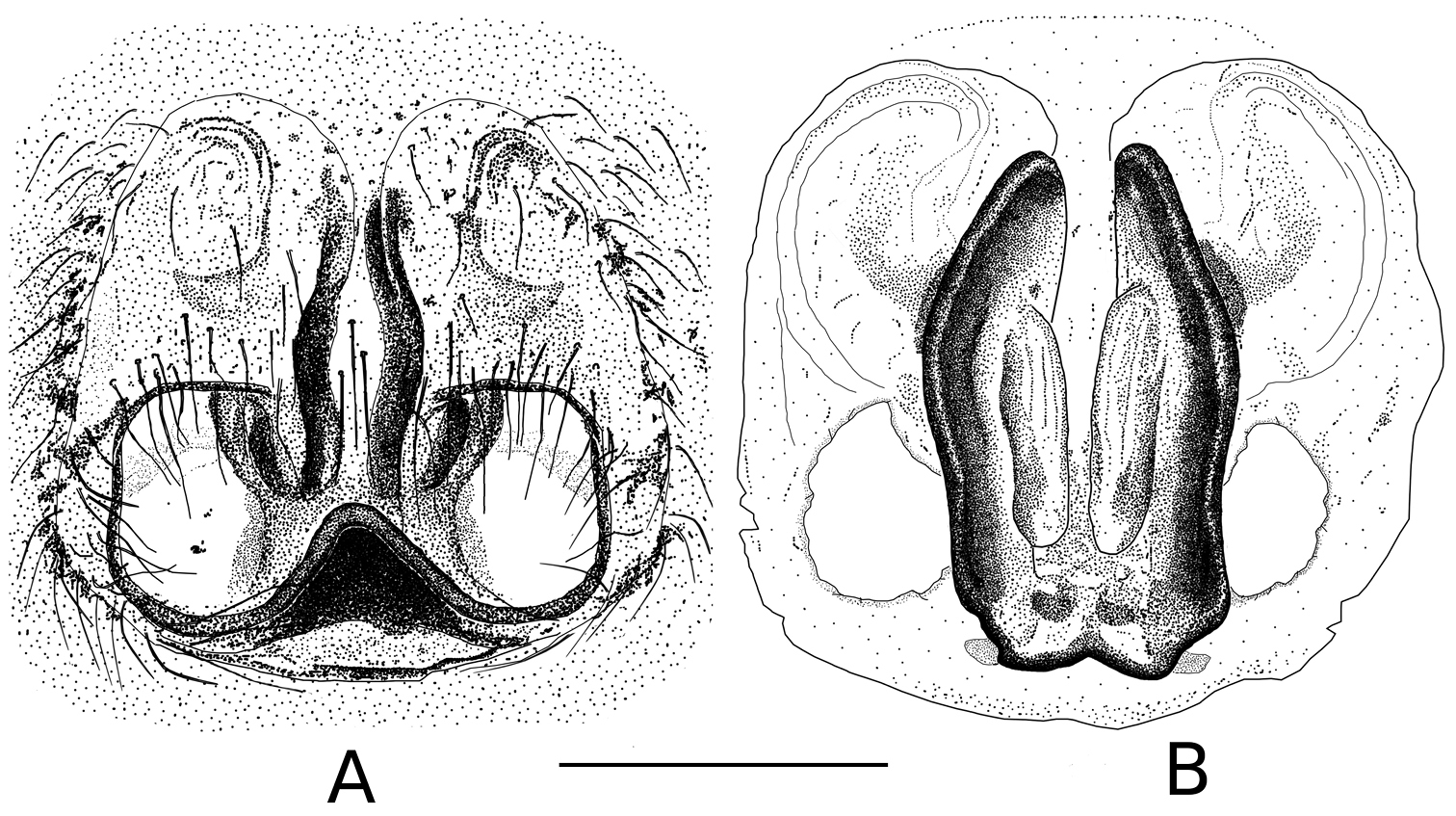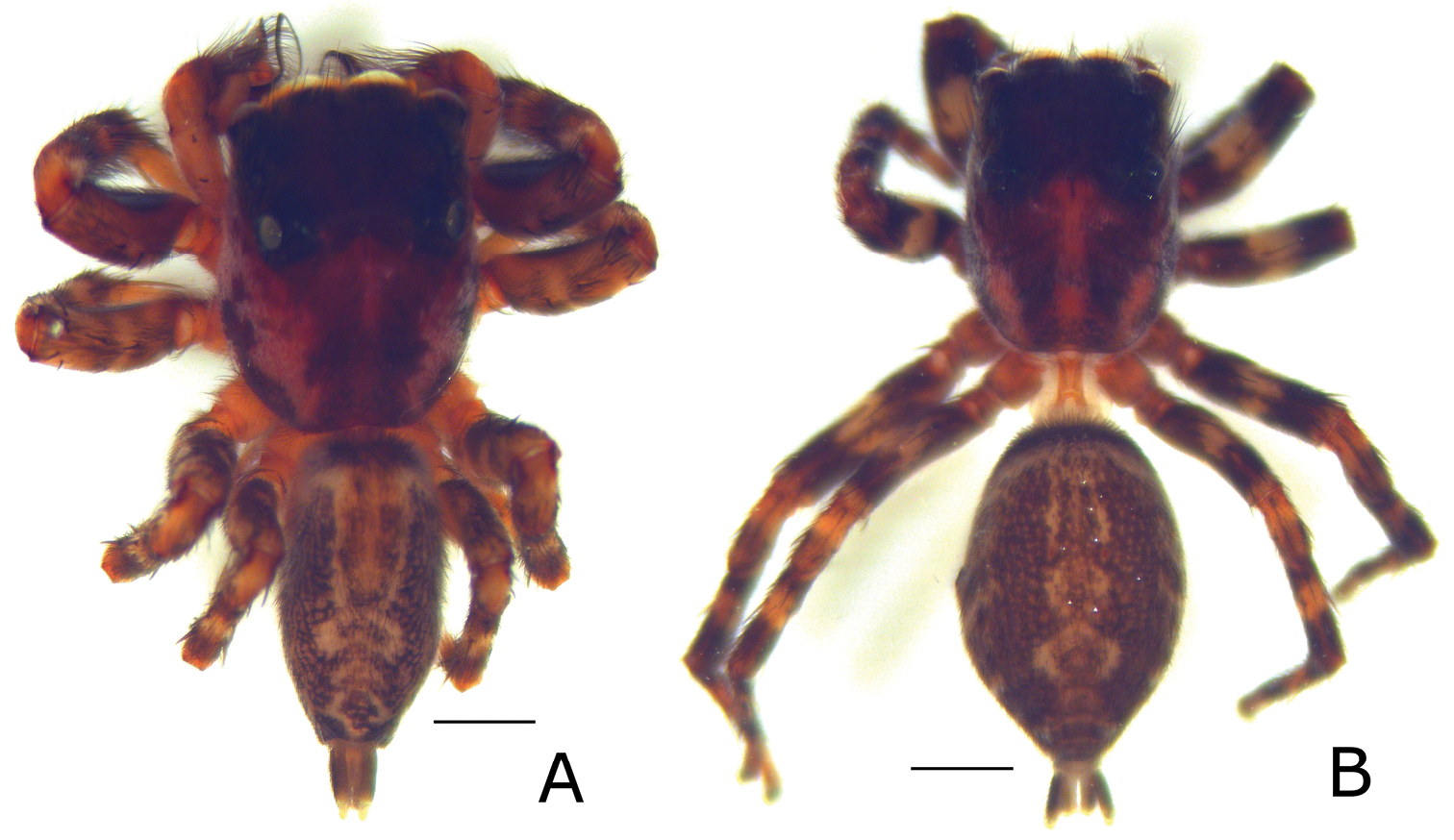






Citation: Courtial C, Picard L, Ysnel F, Pétillon J (2014) Validation of Eustiromastix guianae (Caporiacco, 1954) (Araneae, Salticidae) with a first description of the female, and additions to the salticid fauna of French Guiana. ZooKeys 420: 11–18. doi: 10.3897/zookeys.420.6977
In this paper, we validate the doubtful species status of E. guianae, with redescriptions of (supposedly lost) type and holotype males, and a first description of the female. Both sexes are measured and illustrated by pictures of habitus and copulatory organs. Seventeen new salticid species for French Guiana are also reported and a detailed catalogue of all salticid species from the Trinité National Nature Reserve is provided.
Jumping spider, tropical forest, South America, doubtful species
The history of arachnology in French Guiana started in 1871 with the publication of the first catalogue by Władysław
Based on the rediscovery of the type specimen in the collection of the MNHN of Paris and on the collection of several males and females, we propose to validate the doubtful species Eustiromastix guianae here, and provide the first description of the female. In addition we provide a detailed catalogue of all salticid species from the Trinité National Nature Reserve, with new species for French Guiana after
The following abbreviations are used:
AER anterior eye row; ALE anterior lateral eyes; AME anterior median eyes; PER posterior eye row; PLE posterior lateral eyes; PME posterior median eyes; NNR National Nature Reserve.
All the fresh specimens examined in this study were collected on leaves of several tropical trees during a survey at the Trinité NNR in December 2010. Measurements (in millimetres as in
Regional literature on salticids was consulted and the presence of valid species after
Holotype: male (MNHN): French Guiana, Charvein. 7 females, 3 males and 1 subadult male Trinité NNR, 04°36'02"N, 53°24'43"W, 09.XII.2010, Julien Pétillon and Cyril Courtial. Specimens have been deposited in the Museum National d’Histoire Naturelle, Paris (male collection number: AR 15000; female collection number: AR 15001).
Among salticids, the differenciation between genera of the Plexippeae group is especially complex (
(holotype from Charvein). Figs 1A, B; 2A–D; 5A. Total length 6.54. Prosoma: carapace 2.95 long, 2.35 wide and 1.83 high. Carapace: darkish brown. Cephalic region: black, and darker than thoracic region. Diameter of PME: 0.34; PLE: 0.14; AME: 0.58; ALE: 0.46. Distance PLE-PLE: 1.94; PME-PME: 2.01; PME-PLE: 0.27. Chelicerae: 1.10 long and 0.77 wide, dark brown. One promarginal and two retromarginal teeth. Legs: light brown, with dark annulations. Leg formula 3412. Length of femur: I 2.09, II 1.84, III 2.55, IV 2.27; patella: I 1.29, II 1.04, III 1.17, IV 0.87; tibia: I 1.80, II 1.32, III 1.42, IV 1.40; metatarsi: I 1.26, II 1.10, III 1.70, IV 1.83; tarse: I 0.66, II 0.62, III 0.61, IV 0.70.
Drawing of the Holotype of Eustiromastix guianae male palp (A prolateral view B ditto ventral view) MA: median apophysis, E: embolus. Scale 1 mm.
Pictures of the male palp of Eustiromastix guianae. A–C male palp in lateral, retrolateral and ventral views, respectively D detail of the tibial apophysis, ventral view. MA median apophysis, E embolus. Scales: A–C 1 mm, D 0.5 mm.
Spination: femur I-III d1-1-1, r2-2 p2-2, IV d1-1-1, r1; patella I-II p1, III-IV p1, r1; tibia I-II v2-2-2, III-IV v1-2, p3, r3, d1; metatarsi I-II v2-2, III-IV v2-2, p1, r1, d2-2-2. Abdomen 3.71 long.
Dorsum: greyish with diffuse pale spots, and a median, longitudinal light brown stripe between a pair of longitudinal narrow stripes of white scales anteriorly and a white chevron posteriorly in fresh specimens (see Fig. 5A). Abdominal pattern with a median dark brown band.
Male palp as in Fig. 1A, B. Cymbium flattened apically (Fig. 2A), small retrolateral tibial apophysis, pointed internally in dorsal view (Fig. 2D). Long embolus with an elongated median apophysis at about one third of the total length of the embolus (Fig. 2B, C).
Locality: Charvein.
Figs 3A, B; 4A–C; 5B. Total length: 7.51. Prosoma: carapace 2.75 long, 2.19 wide, and 1.59 high. Carapace: dark brown. Cephalic region: darker than the thoracic region. Diameter of PME: 0.29; PLE: 0.10; AME: 0.62; ALE: 0.32. Distance PLE-PLE: 1.75; PME-PME: 1.83; PME-PLE: 0.30. Chelicerae: 0.83 long 0.49 wide. Legs formula 4312. Length of femur: I 1.66, II 1.52, III 1.85, IV 1.89; patella: I 0.80, II 0.69, III 0.85, IV 0.71; Tibia: I 1.29, II 1.08, III 1.13, IV 1.30; metatarsi: I 0.74, II 0.64, III 1.16, IV 1.46; tarsi: I 0.62, II 0.58, III 0.67, IV 0.67. Spination: femur I-II d1-1-1, p2, III d1-1-1, p1, r1, IV d1-1-1, r1; patella: I-II p1, III-IV r1; tibia: I-II v2-2-2, p1, III-IV v1-2, r1-1-1, d1, p1-1-1; metatarsi: I-II v2-2, III d2-1-2, r1, v2-2, IV d2-2, v2-2, r1. Abdomen: 3.66 long. Dorsum: greyish to blackish (Fig. 5B) with a diffuse pale chevron in median part and a small white spot lateraly. Epigyne and spermathecae: as in Fig. 3A, B. Epigyne with two deep circular genital openings (Figs 3A, 4A). Insemination ducts: long and parallel (Figs 3B, 4B, C). Spermathecae: almost round and small at the base of the vulva (Fig. 4B, C).
Drawing of Eustiromastix guianae epigyne (A dorsal view B ventral view). Scale 0.5 mm.
Pictures of the epigyne and spermathecae of Eustiromastix guianae. A dorsal view B vulva, ventral view after maceration C ditto latero dorsal view. Scale: 0.5 mm.
Habitus of Eustiromastix guianae, male, fresh specimen (A) and female (B). Scale: 1 mm.
Male: Total length: 6.50–7.17, carapace length: 2.40–3.38, carapace width: 2.26–2.66 (n=4). Female: total length: 6.32–7.51, carapace length: 2.75–3.11, carapace width: 2.19–2.31 (n=7).
all specimens were collected together, including males in couple with females in tropical rain forest from beating and sweeping low vegetation.
known only from two localities in French Guiana (Charvein and Trinité NNR) Figure 1 of Suppl. material 1.
Twenty-eight jumping spiders have been identified at the Trinité National Nature Reserve, among them 17 are new for French Guiana (see the catalogue of saticids of the reserve: Table 1 of Suppl. material 1). A total of 102 salticid species is now recorded from French Guiana.
The authors thank Marguerite Delaval (Office National des Forêts, ONF) and ONF for funding the expedition to the Trinité National Nature Reserve; Christine Rollard and Christophe Hervé (Museum National d’Histoire Naturelle – Paris) for allowing access to the bibliography of the Arthropod laboratory and permitting the consultation of Caporiacco’s collection; Christophe Hervé who found the type of Eustiromastix guianae; and Alain Canard and Boris Leroy for field support. Jeremy Miller, Tamás Szűts and two anonymous referees provided useful comments on an earlier draft.
Electronic supplementary material
Cyril Courtial, Lionel Picard, Frederic Ysnel, Julien Pétillon
Data type: Specimens data
Explanation note: Table 1. Detailed records of all salticid species in the National Nature Reserve Trinité. Figure 1. Map showing localities of NNR Trinité and Charvein.
Copyright notice: This dataset is made available under the Open Database License (http://opendatacommons.org/licenses/odbl/1.0/). The Open Database License (ODbL) is a license agreement intended to allow users to freely share, modify, and use this Dataset while maintaining this same freedom for others, provided that the original source and author(s) are credited.




